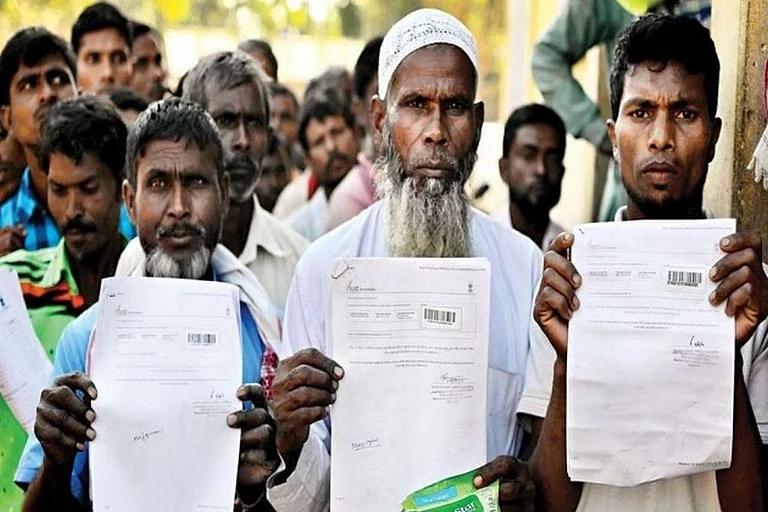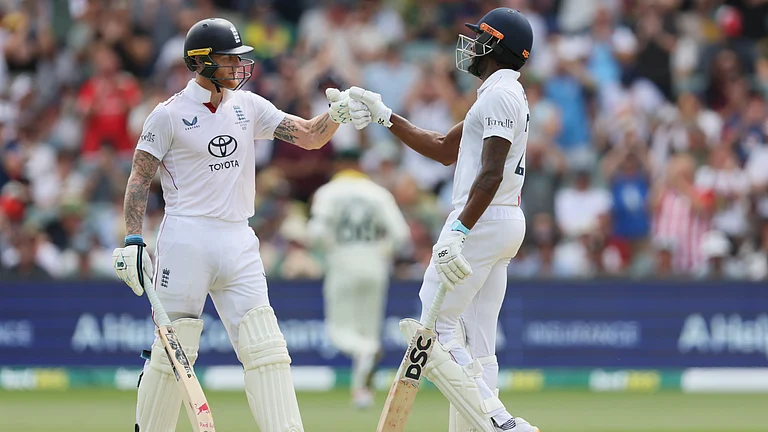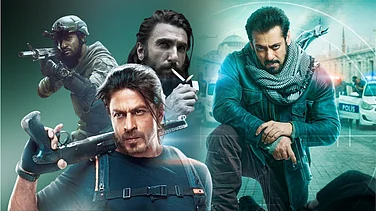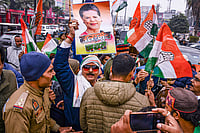A man and a woman are travelling by a taxi. They are sitting close to each other, yet an invisible barrier separates them. The taxi glides through the roads of Mumbai and we see apartment buildings and marketplaces pass by. Inside the taxi, however, the intensity of unspoken emotions is heightened. The woman frequently looks towards the man but avoids eye contact. The loose end of her sari flutters in the wind, caressing his hand that lies next to her on the car seat. The scene switches back and forth between reality and fantasy, as the woman imagines herself, sometimes in the arms of the man next to her, and sometimes in the arms of her actual partner. The wide, winding roads of Mumbai bear witness to this intimate moment of a woman’s unspoken longings.
This is a scene from the film Rajnigandha, directed by Basu Chatterjee, and starring Vidya Sinha, Amol Palekar and Dinesh Thakur. The scene plays out in the backdrop of a song and picturises, with rare sensitivity, the complicated emotions of a young, highly-educated woman living a sheltered, middle-class life, who is unexpectedly confronted by her past.
Rajnigandha is an adaptation of the short story, Yahi Sach Hai by Mannu Bhandari, and addresses the emotional tug-of-war experienced by a woman who is momentarily torn between her past love and her present relationship. Devoid of melodrama and focusing on conversations and ruminative silences, between characters or alone (set in the backdrop of music composed by Salil Chowdhury), the film was a hit, and won the Best Film at the Filmfare Awards in 1975. For film scholars and the audience, Rajnigandha belongs to a trend in Indian films that has now become popular as Middle Cinema.

Although its journey is said to have been in the making since the 1950s, Rajnigandha’s unexpected success is considered an important moment for Middle Cinema in India. As the name suggests, Middle Cinema took a middle-ground approach to filmmaking, between over-the-top movies of mainstream Bollywood of the 1970s and 80s, and the serious, realistic, art-house cinema that ran parallel to it. According to Professor Satish Poduval, Middle Cinema, “like much of art-house cinema, was built around ‘ordinary’ characters, settings, conversations and events (except that the ambience here was resolutely middle-class and upper caste). It usually had a lesser-known but trained cast and crew and the consequent low production costs allowed a niche market to be cultivated”. Filmmakers such as Basu Chatterjee, Hrishikesh Mukherjee, Bhimsain, among others, were considered frontrunners in this new trend. With time, Middle Cinema has gained a loyalty of its own, drawing from urban nostalgia as well as for the feel-good plots that appealed to middle-class sentimentality.
Middle Cinema presented the audience with an opportunity to see some of their dreams and aspirations get reflected onscreen. Emergent middle-class desires, urban aspirations and anxieties found an onscreen outlet away from the unrealistic crescendo-reaching climaxes of extravagant masala movies, or the sombre reminders of social injustices of art-house cinema. However, while Middle Cinema espoused the ordinariness of its subjects, these movies were also able to blur out important developments occurring in the socio-political backdrop of the country. India in the 1970s was witnessing turbulence in many quarters. The country was still dealing with the aftermath of a harsh drought in the Eastern parts of the country from the previous decade. There was the Bangladesh War, in which India under Indira Gandhi became a key player. Despite Indira’s emphatic slogans for poverty eradication, the country continued to struggle with economic distress as well as labour unrest and student protests. On June 25, 1975, the Emergency was imposed and continued for 21 months, a tense moment in the history of Indian democracy.
Mainstream cinema reflected the growing disgruntlement with these frustrations through the persona of the ‘angry young man’, embodied by Amitabh Bachchan and fuelled by Salim-Javed’s fiery scripts. The ‘angry young man’ was a dissenting voice, often rising from the margins to become the vigilante figure fighting social injustices. These movies had their generous dose of action, drama and romance, and of course a hero willing to break the law, if they had to, in order to fight the bad guys. Unsurprisingly therefore, they found an eager and hungry audience. In contrast, Middle Cinema advocated for the obedient and polite protagonist, a character portrayed by Amol Palekar, who embodied acceptable middle-class gentility, perhaps even naivete to a certain extent. Thus, the 70s saw the emergence of two distinct hero archetypes that can be seen as contrapuntal to each other but, as Poduval puts it, “it might be useful to attend to how they nevertheless acted in tandem: the angry and the affable young men were both forms of a gendered building, enabling a distinctive 1970s male subject to negotiate a terrain that he considered to be ‘his’ due…”.

Middle Cinema’s men were not impervious to a sense of social frustration, aspiration for upward mobility, disappointments and desires, although their modus operandi in dealing with this was not to rebel outrageously, but seek personal reconciliation or ingenious resolutions. For example, in Chhoti Si Baat, Amol Palekar’s character Arun, who is routinely humiliated by his romantic rival (played by Asrani), takes refuge in the lifestyle coaching of Ashok Kumar’s Colonel Julius Nagendranath Wilfred Singh. What the savvy and worldly-wise colonel teaches him can only be summed up as a set of easily learnt skills and some dubious ploys to transform the protagonist into a street-smart urbane youth who is able to confidently steer himself through the confusing world of chopsticks, table tennis and romantic seduction. In Gharaonda, a film about a young couple’s desire to own a home in populous Mumbai, attempts at easy resolutions backfire and the protagonist ends up losing both his love interest and his prospects, although in the end, he resolves to start over again. The ending of Gharaonda seems to reassert the overarching message in Middle Cinema that the urban middle-class character’s power is limited in the public, and that it’s in the personal sphere where he can truly assert agency.
In most of Middle Cinema, personal conflicts graze by larger social causes, that too when they resonate with the protagonist’s personal life. For example, in Basu Chatterjee’s first film, Sara Aakash (which can be seen as a precursor to his later, more light-hearted films), the protagonist shies away from getting to know his newly-wed wife, as he is conflicted by the repercussions of marriage on his ambition of becoming a worthwhile contributor to society. As he mouths the writings of Swami Vivekananda and Subhas Chandra Bose, he must confront his own insecurity in perceiving conjugality as an ideological handicap. Despite these films being replete with subliminal statist messaging, such as conscious family planning or championing inter-caste marriage, they avoid anti-establishment, anti-State sentiments, focusing instead on the protagonist’s personal journey.

While the men of Middle Cinema were characterised by this gentility, who were the women in these films? Sometimes ruminative, sometimes assertive, the women were anything but passive subjects. They were active participants in urban sociality, were educated, held jobs, exercised choice in romance and took initiatives when necessary; their mobility expanding beyond the domestic, their desires stretching beyond the conjugal. Despite this, however, the portrayal of women in Middle Cinema remained within the same middle-of-the-road paradigm. Unlike mainstream cinema’s tropes of damsels-in-distress, virtuous lovers and vamps, Middle Cinema accorded more agency to their female protagonists, steering clear of gratuitous portrayals of female suffering and the kind of subjugation that demands rescue—a common trope in mainstream Bollywood—but they stopped short of addressing serious issues of gender violence or women’s rights and their intersection with socio-economic class and caste conflicts that art-house filmmakers such as Shyam Benegal, Mani Kaul, Ketan Mehta and others, were not shying away from exploring, around the same time.
However, what films from this trend did not avoid was centre-staging the inner life of women before the film audience, in a manner that was almost non-existent in mainstream cinema. In Rajnigandha, Vidya Sinha’s character is a PhD scholar in search of a job. She is an independent young woman on the verge of embarking on a possibly new romantic prospect. Yet, the film spends ample time delving on her character’s emotional dilemma as she contemplates her complicated desires. There is no judgment projected on her emotional conflict. Instead, we see a film that explores female desire with a nuance and tenderness that is still rare in Bollywood. Female desire is not just addressed through songs and evocative cinematography, it is indulged.
In Chameli Ki Shaadi, a satire on caste, Amrita Singh’s character is openly defiant of her family and fiercely assertive of her desire to marry her lover, much to the chagrin of her family. Abhimaan, meanwhile, explores the devastating effects of marital jealousy on a young woman whose superior talent becomes the cause of marital conflict. In Guddi, the plot revolves around Jaya Bhaduri’s crush on a film star, Dharmendra, playing himself. However, even as these films give space to women’s longings, it is bound within the ambit of patriarchal sanctions, gentility and virtue, reflective of the place of women in middle-class society in India. A very good example of these limits is seen in Chhoti Si Baat, when Colonel Julius Nagendranath Wilfred Singh tries to stop Amol Palekar’s character from engaging Vidya Sinha in a game of seduction by reminding him that she is ‘not that kind of girl’.
Middle Cinema, thus, gave us characters who toed the line of middle-class civility but embarked on poignant emotional journeys through their relationships, shaped by the framework of the emerging (upper) middle-class ethos of the time. Even though most Middle Cinema avoided addressing significant current socio-political issues that found an echo in mainstream masala movies, they managed to give the audience a world of relatable emotional quandaries and lovable characters that have managed to stand the vagaries of time—a world of polite men and contemplative women, and their personal journeys.
(This appeared in the print edition as "Lights, Camera, Emotion")
(Views expressed are personal)
Rituparna Sengupta is an environment and urban researcher with an unshakeable interest in films
























